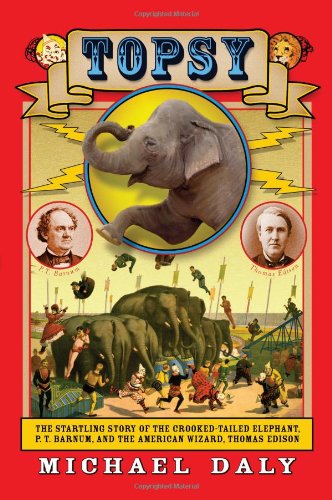
Poor Topsy. She had
the sort of unhappy life that could've served as the background for an old Disney cartoon: captured and separated from her mother,
she was brought to America and put to work as a circus attraction, where she was often subjected to brutal treatment by trainers. Disney would've given her a happy ending, but Topsy had no such luck. In 1903, Topsy was put before an audience and electrocuted for being a “bad” elephant.
Michael Daly’s highly readable historical saga, ‘Topsy: The Startling Story of the Crooked
Tailed Elephant, P.T. Barnum, and the American Wizard, Thomas Edison’ covers
a lot of territory, starting with America’s strange fascination with elephants,
the rise of the American circus, and
Thomas Edison’s all-consuming thirst for power. The execution of Topsy has become a sort of
urban legend (it was filmed by Edison’s company, and you can see it on YouTube)
but it wasn't the only time an elephant was executed in front of a crowd
of gawkers. Elephants intermittently broke their chains and stomped a
trainer to death, which lead to the animals being put down, either with bullets, poison, or by
hanging. Edison, as big a showman as P.T.
Barnum, convinced circus owners that electrocution was the most efficient way
to get the job done.
What’s most unsettling about this account of Topsy's
end is that humans seemed to enjoy seeing elephants suffer. Consider
that two of the first three elephants brought to America were promptly shot and killed by
local yokels, including a couple of boys who wanted to test a circus barker’s
claim that the creature was “bullet proof”. Or consider how easy it was for
trainers, after a few drinks, to turn vicious. Throughout the book, despite the occasional appearances
by the ASPCA, there’s a sense that elephants and humans are not a perfect match,
as if humans, when confronted by the magnificent beasts, were overtaken by a
horrific case of ‘short man complex’.
Daly, a Pulitzer Prize nominee, tells a good story, so even
the chapters about elephant behavior come off as interesting and entertaining,
rather than strictly academic. Daly’s
strongest writing is about the early elephant trainers, who ranged from the
maniacal to the benevolent. Some were
drunks who dealt with an angry elephant by blasting him in the face with a
shotgun, often leaving it blind or injured. There
were others, though, such as the legendary ‘Eph’ Thompson, an African-American who
used a calm, sweet demeanor and could teach an elephant to do a somersault. Then
there was the renowned Stewart Craven, who began as a typically sadistic
trainer, but had a change of heart and inspired decades of future trainers to
try a gentler approach.
Edison comes off as a greedy and pugnacious man determined
to flood the world with his inventions. The
early days of electricity were even more horrifying than the treatment of
circus animals, such as the time lineman John E.F. Meeks died dangling on
a live wire, “as blue flames shot out of his
mouth and nostrils and sparks exploded from the soles of his feet.” It was only a short jump from the tragic
death of Meeks to the invention of the electric chair. As for Topsy, she was brought to America as a
baby, and enjoyed 30 years as a headliner before killing a trainer and causing
several disturbances. Her death, which took place at Coney Island’s Luna Park,
was the first time a living creature was shown dying on film.
Fortunately, the grisly aspects of Daly’s book are offset
with many moments of awe, such as when a herd of captive elephants remain serene
during a major storm, emerging from the wreckage like “a procession of towering
tranquility,” or when a throng of more than 3000 people gathered on a river
bank to see some elephants taken to the water where they played
and bathed. True, elephants could bang
on a drum or stand on their heads, but elephants always seem more majestic in a more natural setting. The tricks and stunts may be
cute, but after reading Daly’s chronicle of Topsy and other elephants driven
mad by captivity, I think I’d rather see
an elephant bathing in peace, than slumping around like a working
stiff under the big top.
No comments:
Post a Comment